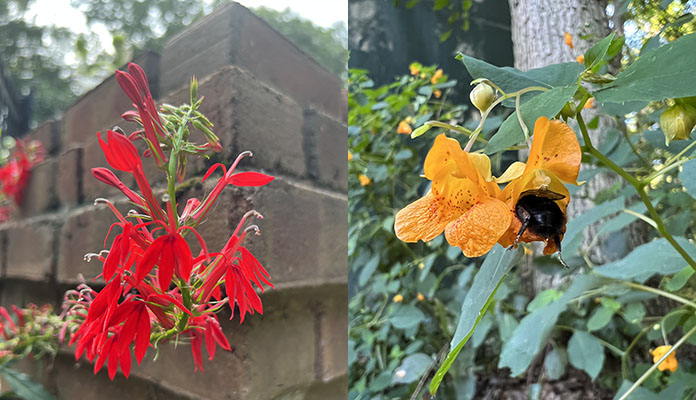 (left) A native cardinal flower grows along a brick wall, (rignt) A bumblebee visits some blooming jewelweed.
(left) A native cardinal flower grows along a brick wall, (rignt) A bumblebee visits some blooming jewelweed.
Photos by: Sarah Witcher One of the most common questions we get here at Wild Acres is from gardeners who have recently learned about the importance of native plants and are wondering where to start. We get it! There’s a lot of information and an abundance of choices when it comes to starting a new garden, or transitioning your existing garden to native species. This step-by-step list breaks down the basics to help get you started!
-
Determine your vision. What does your ideal end result look like? Is it a
meadow, a woodland, low shrubs and
flowering plants, or a
mowable lawn? A quick search online will help you find photos of professional horticulturalists’ and home gardeners’ results from which to draw inspiration and imagination.
-
Get to know your local plant community. Learn to identify the native plants that are already growing in your area. Knowing your botanical neighbors will offer the best clues to what types of plants might thrive on your site. Tools like field guides, dichotomous keys, or online databases like
Seek and
Maryland Biodiversity Project can help.
-
Determine your site conditions. Even native plants need a very specific set of soil, water, and sunlight conditions to survive and thrive, so make some observations of the area you want to plant. Maryland has a wide variety of soil types, so a
soil test is always a good place to start. Multiple tests may be needed for larger properties.
-
Prepare your planting site. Starting small is always encouraged! Remove
invasive species (here are some
quick reference cards and a
reference booklet),
kill your lawn, augment the soil as needed, and make a beautiful home for your new plantings.
-
Choose your plants. This is probably the place where most people get the most overwhelmed, and we don’t blame you! Fortunately, depending on what kind of learner you are, there are plenty of resources available to help you choose. You can visit a nearby botanical garden, arboretum, or
nursery that carries native plants and ask their knowledgeable staff about their favorites (sometimes, your biggest limitation will be availability, so this is a good place to start). Visit our website for a guide to Chesapeake Bay native plants, either a
printable version or use filters to sort this
online version. You can use the University of Maryland Extension’s “Ask A Master Gardener” service. And, you can review the
many resources on our DNR website provided by our state botanist
-
Make it happen! Choose a spring or fall planting date and make it happen! Don’t forget to consider how to protect the soil around your new babies from unwanted
weeds. Also, make sure to water until your plants get established -- even native plants need plenty of tender loving care when they’re just getting started.
-
Celebrate your successes, and learn from your losses. Sometimes, a plant just isn’t going to be happy in a location even when you’ve done everything right. Take a cue from Nature and follow her lead. Can’t remember what you planted? Me neither! The best plan to combat that is to use garden labels or keep good notes! And remember,
certifying your garden is a great way to passively teach everyone who sees it and show off your accomplishments!